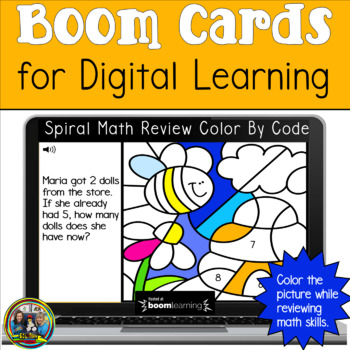End of the Year Activities Spiral Math Review Color By Code Boom Cards
- PDF
- Internet Activities
Also included in
- Students will increase their reading comprehension and review math skills with this engaging End of the Year Activities Bundle. They will develop vocabulary while doing literacy activities with these fun and engaging Boom cards! They can listen to the recorded voice reading or read it themselves. ThPrice $20.00Original Price $31.00Save $11.00
Description
Do your students need to review their math skills? This no-prep, exciting color by code progression math game will have your students practicing their math in a fun way! Students love these engaging Boom Cards! There is audio so the directions can be read to the students. Students will love coloring the bee as they solve problems. These cards are great for Distance Learning or to use in math centers!
Skills Covered:
Number Order
Addition
Subtraction
Money
Telling Time
Place Value
Greater Than, Less Than, Equal To
Word Problems
Skip Counting
Fractions
Tens and Ones
Vertices
Balancing Equations
We have also included paper bee images that can be used to help students with counting, addition, subtraction or creating patterns.
Digital Boom Cards offer an easy way for teachers to assess their students. You can use these Boom Cards with your interactive whiteboard, tablets or laptops! They are self-checking so the students know when their answers are correct.
Make sure you click on preview at the top and you can try out this fun game!
Click Follow to see all of our new resources!
Parents: If you have a child that needs help with addition or subtraction, we have included printable images to help them. It is a nice way to incorporate kinesthetic with digital learning. We have also included a teacher guide with at home tips.
What's a BOOM CARD?
To use Boom Cards, you must be connected to the Internet. Boom Cards play on modern browsers (Chrome, Safari, Firefox, and Edge). Apps are available for modern Android, iPads, iPhones, and Kindle Fires. For security and privacy, adults must have a Boom Learning account to use and assign Boom Cards. You will be able to assign the Boom Cards you are buying with "Fast Pins," (a form of play that gives instant feedback to students for self-grading Boom Cards). For assignment options that report student progress back to you, you will need to purchase a subscription. If you are new to Boom Learning, you will be offered a free trial. Read here for details: http://bit.ly/BoomTrial
Check out the rest of our Boom cards!
We also have a Flower Addition Boom and an Evergreen Fractions Boom
Hello! We are Pam and Brittany, a mother and daughter team from Dynamic Learning, and we love creating dynamic products that make learning fun and engaging for your students!
We appreciate all your support!






